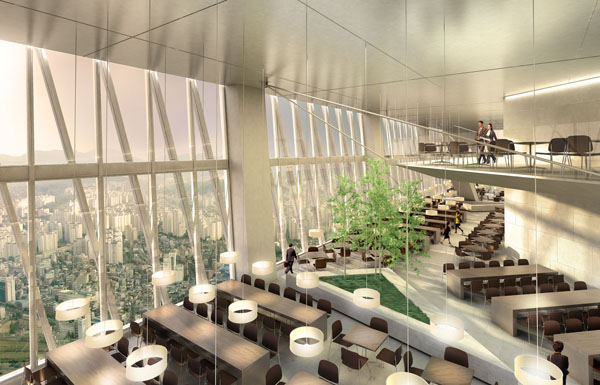It may seem strange to call 1,125-foot skyscraper efficient, given the energy it takes to build such a monumental structure. But the 64-story Diagonal Tower being planned for the Yongsan International Business District of Seoul, South Korea, actually fits the bill, with several passive systems and a design that requires 25 percent less structural steel than similarly sized buildings.
The tower, designed by SOM and scheduled for completion in 2016, will provide nearly 1.83 million square feet of office space. Because of the building’s large triangular facets that support most of the building’s weight around the perimeter, most of the offices will have unobstructed views with no internal support columns necessary, besides the 40-foot-wide square central core.

About a third of the way up the tower, the square floor plan is rotated 45 degrees, creating the characteristic triangular shapes on the façade. The floor plan is shifted another 45 degrees at the two-thirds mark as well. The resulting facets on the building’s outer skin help to break up the laminar flow of wind around the tower and reduce the wind load placed on the façade.

The diagonal metal support beams framing each facet are also hyper-efficient and allowed SOM designers to use 25 percent less steel without sacrificing strength. This also reduces the amount of waste produced and during the construction of the tower and allows crews to work faster.

To reduce energy costs, the tower plans include several passive environmental control strategies, including sunshades that will be placed at strategic locations and at varying angles on each facet to enhance solar gain and maximum natural daylight in the winter while providing cool shade and protection against glare in the summer. The glazed exterior is a triple-paned curtain wall of glass, which helps prevent energy loss.
Rather than a traditional air-driven HVAC system, the tower will employ an active chilled beam system, using water as a medium for transferring heating and cooling energy. This method, SOM says, uses less energy than a conventional HVAC system and will provide a more comfortable environment for tenants.
The mixed-use skyscraper will be located in the bustling Yongsan District, which is undergoing heavy redevelopment with several other mega-tall buildings. The Diagonal Tower will include several sky lobbies, a fitness and indoor running track, two retail pavilions, a multi-use auditorium, a cafeteria and penthouse executive lounges on the top floors.